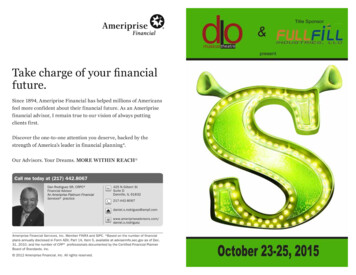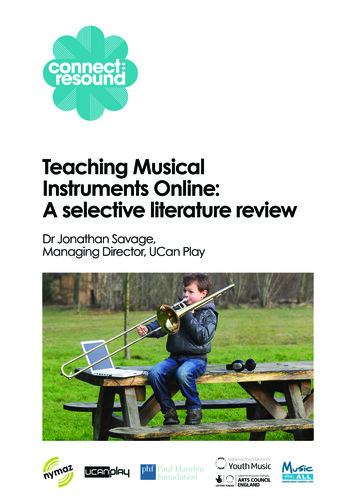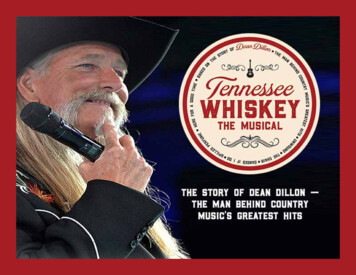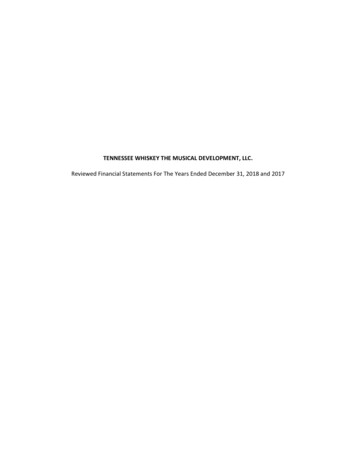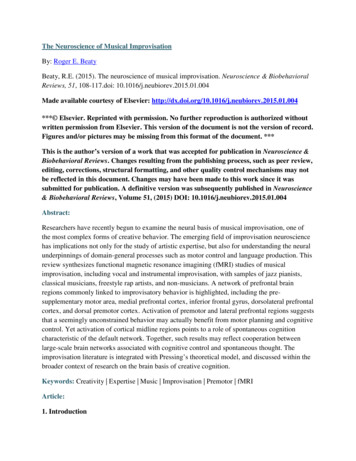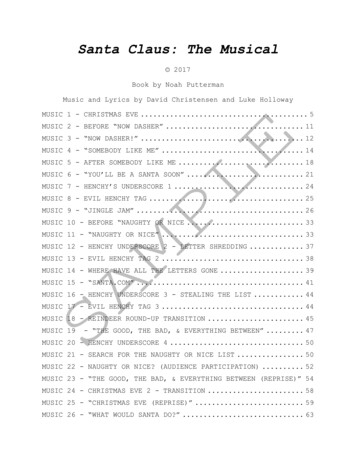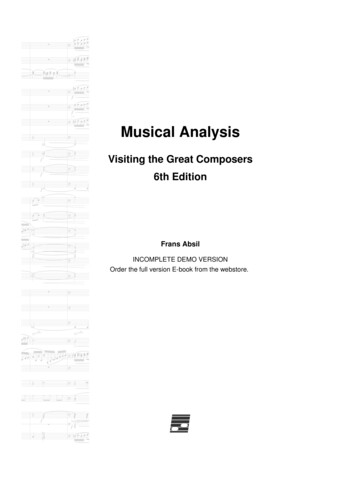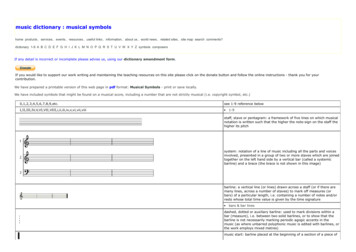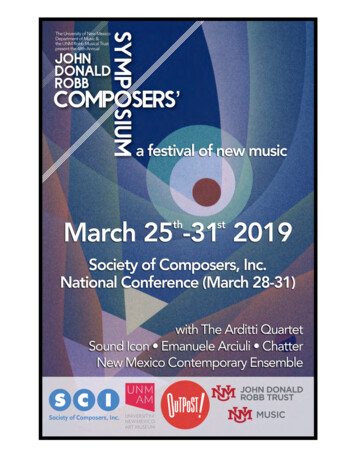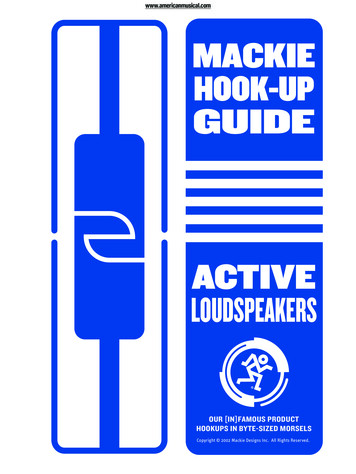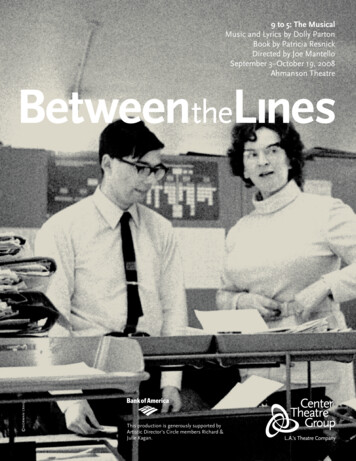
Transcription
norman craig9 to 5: The MusicalMusic and Lyrics by Dolly PartonBook by Patricia ResnickDirected by Joe MantelloSeptember 3–October 19, 2008Ahmanson TheatreThis production is generously supported byArtistic Director’s Circle members Richard &Julie Kagan.
Welcome601 West Temple StreetLos Angeles, CA 90012Between the Lines continues with the world premiere of Dolly Parton’s9 to 5: The Musical, based on the 1980 hit movie of the same name,which starred Dolly Parton, Jane Fonda and Lily Tomlin. The film comedydid blockbuster business upon its original holiday release, and Dolly’sinfectious theme song became an anthem for office workers aroundthe world. We’re taking a look at some of the social currents that made theoriginal 9 to 5 film possible, as well as a behind-the-scenes peek at howthe creative team is recreating its world on the stage.Doug CooneyWriterRachel FainManaging EditorHowie DavidsonEditorJean KlingProofreaderIrene KaneshiroGraphic DesignerBetween the LinesFeedback9 to 5: The MusicalTicketsInformation2 Between the Linesl to r: Stefanie J. Block, AllisonJanney and Megan Hilty in9 to 5: The Musical. photo byjustin stephens.
Cast of CharactersViolet Newsteadsingle mom;secretaryallison janneyJudy Bernleyrecent divorcée;secretarysteffanie j. blockDoralee Rhodeshappily married;secretarymegan hiltyFranklin Hartthe boss; acorporate executiveat ConsolidatedIndustriesmark kudischJoefrom accounting;the office hunkandy karlRoz KeithHart’s administrativeassistantkathy fitzgeraldMargaretthe office lushkaren murphyKathythe office gossipann haradaMaria Delgadothe office innocentioana alfonsoMissy Hartthe boss’ wifelisa howardMr. TinsworthyChairman of the Boardmichael x. martinJoshViolet’s sonvan hughesDwayneDoralee’s husbandcharlie pollockDickJudy’s husband,soon to be exdan cooneyEnsembletimothy georgeandersonSwingjennifer balagnaEnsemblejustin bohonEnsemblepaul castreeEnsemblejeremy davisEnsembleautumn guzzardiEnsemblebrendan kingEnsemblemichael mindlinSwing,Dance Captainmark myarsEnsemblejessica lea pattyEnsembletory rossEnsemblewayne schroderEnsemblemaia nkengewilsonEnsemblebrandi wootenCenter Theatre Group Between the Lines 3
SynopsisPope Paul IV was driven around NewTumble outta bedYork in a Lincoln-Mercury limousine,shown here in a Ford Motor CompanyAnd stumble to the kitchenpublic relations photo.Pour myself a cup of ambitionYawnin’, stretchin’, try to come to life.–Dolly Parton, “9 to 5”IIn 1979, the modern conveniences of corporate Americaincluded electric typewriters, Rolodex cards, mimeographmachines and carbon paper. Humongous photocopymachines hummed and rattled in separate rooms down thehall. Office dress codes were strictly enforced – and sexismwas as common as a mid-morning cigarette break. In the filmcomedy 9 to 5, Dolly Parton, Jane Fonda and Lily Tomlin staras three secretaries who forge an unlikely bond to combatworking conditions in their office. Twenty-five years later, thismusical adaptation features Dolly Parton’s original hit themesong, a more recent hit and 17 brand new tunes. Judy Bernley,a recent divorcée, joins the secretarial pool at ConsolidatedIndustries after her husband leaves her for a younger model,his own secretary. Violet Newstead, the department supervisorand a company veteran of 15 years, is charged with training thenewbie, as she has done for scores of other employees whohave been promoted above her, including her boss, FranklinHart, Jr. The office orientation includes a word of advice: don’tbefriend Doralee Rhodes, a buxom, vivacious country girlsuspected of sleeping with the boss. Unbeknownst to them,Doralee is actually happily devoted to her husband; Harthas been spreading rumors of a torrid affair just to brag tohis associates.When Violet is again passed over for an important promotion,she reaches her breaking point. In her anger, Violet tellsDoralee that her “affair” with Hart is common knowledge.Doralee confronts Hart about his lies, threatening to gun himphoto by joel bombardier.4 Between the Lines
“ I’m not offended by dumb blondejokes because I know that I’m not dumb.I also know I’m not blonde.”–Dolly PartonBy the 1970s, attitudes toward womenin the workplace had not evolvedmuch past this 1955 typewriter ad.down. Judy, meanwhile, has witnessed inequities in the officesystem and reaches her own breaking point. In a huff, thethree women leave the office and converge at Violet’s house,where they indulge in a marijuana cigarette that Violet hasreceived from her teenage son. With their inhibitions released,the ladies voice revenge fantasies targeting their “sexist,egotistical, lying, hypocritical bigot” of a boss. In a farcical turnof events, each woman’s fantasy comes true.influence, the hostile, oppressive workplace turns into anequitable, efficient and friendly environment. Soon Violetbecomes convinced that Hart has been embezzling moneyfrom Consolidated Industries, and the women plan on usingthe information to blackmail him. But when Hart escapes,there’s no telling whether Violet will be able to prove hisculpability, or whether their charade will prove to be theirown downfall.After a series of comic misunderstandings, the three womenimprison Hart in his own home and effectively seize completecontrol of their department, aided by the ability to forge theboss’ signature. With the women’s gentler and more sensitivephoto courtesy of millie motts.Center Theatre Group Between the Lines 5
Bring the PopcornTThe great musicals of Broadway’s golden era – My Fair Lady,The Sound of Music, Oklahoma, Show Boat and countlessothers – were freely adapted from popular plays, novels andmemoirs. When musicals sought inspiration from Hollywood,the underlying movie served as a point of departure for themusical adaptation – which is evidenced right down to thereinvented title. Joseph L. Mankiewicz’s movie All About Evebecame the musical Applause, Billy Wilder’s Some Like It Hotbecame Sugar, Wilder’s The Apartment became Promises,Promises and Ingmar Bergman’s Smiles of a Summer Nightbecame A Little Night Music.By contrast, many of Broadway’s biggest hits today offerloyal recreations of movies that were already box officesuccesses, faithful to the iconic screen moments and true tothe title on the marquee. Notable examples include Hairspray,Crybaby, The Producers, The Full Monty, Young Frankenstein,Legally Blonde, The Wedding Singer, Grey Gardens, DirtyRotten Scoundrels, Chitty Chitty Bang Bang, Thoroughly ModernMillie and Mary Poppins.This bonanza of musicalized movies on Broadway began withthe enormous success of Walt Disney’s Beauty and the Beast6 Between the Linesin 1994, followed by The Lion King in 1997. The blockbusterphenomenon installed a veritable commercial pipeline fromHollywood to Broadway. In addition to the obvious financialincentives, the trend also represents a simple cultural shift.Books don’t become musicals anymore because far morepeople watch movies than read books. The cinema offers aready and substantial pool of material for adaptation withinstant name recognition at the box office.Large numbers of ticket buyers also respond to a senseof familiarity and are drawn to movie titles they recognizefrom the multiplex. ‘’It takes a little bit of the pressure offthe audience to follow the story,’’ says Terrence McNally, theplaywright and book writer for The Full Monty. With the risingcost of ticket prices, audiences want more bang for their buckand a guarantee they’re going to enjoy the show.From the perspective of the creative artists involved, moviesoffer already-established characters that people can relate toand tightly structured storylines with moments of passion andjoy that translate well into song. At the same time, much-lovedmovies also provide memorable cinematic moments that can’talways be translated onto the stage. When Jeanine Tesori was
Talk About What situations or events have triggered new trends in film,TV and stage? What about these happenings caused peopleto create or to crave a particular styleof entertainment?given the job of composing new songs with lyricist DickScanlan for Thoroughly Modern Millie, her first impulse wasto avoid the 1967 movie. “I find the images too hard toshake,” she said. “They’re written in permanent ink.”Jukebox musicals, shows celebrating the works of a particularpop star, have also proliferated Broadway in recent years.Successful examples include Jersey Boys, featuring the lifeand career of The Four Seasons, Mamma Mia!, the ABBAmusical and Movin’ Out, all-singing, all-dancing Billy Joel.In this sense, 9 to 5 offers a two-for-one opportunity:a musical that brings to life a favorite comedy, and a musicalthat showcases the work of Dolly Parton.The prevalence of popular films and pop tunes on Broadwayalso signals another cultural shift. Gone are the dolorousmusical epics of Evita, Les Misérables and Miss Saigon.Nowadays, Broadway audiences want to leave the theatrewith a catchy tune in their heads and an easy smile on theirfaces. And Broadway producers are eager to provide.What Things Cost in 1979Average New HouseAverage Annual IncomeAverage Monthly RentA Gallon of GasA SONY Walkman 58,100.00 17,500.00 280.0086 200.00Coulda, Woulda, ShouldaEveryone has thought of a snappy comeback after the fact.The French expression “l’esprit de l’escalier” (translated“the spirit of the staircase”) refers to all the things you thinkto say when it’s too late and you’re on your way out.Who is the worst boss you’ve ever had – summer jobs count– and what are some of the things you actually said or did –or “coulda, woulda, shoulda” did?Center Theatre Group Between the Lines 7
“ I wanted to be the first womanto burn her bra, but it wouldhave taken the fire departmentfour days to put it out.”Setting & Context–Dolly PartonPolitical actions like this 1970 march inWashington, D.C., were common duringthe Women’s Movement.Workin’ 9 to 5What a way to make a livin’Barely gettin’ byIt’s all takin’ and no givin’They just use your mindAnd they never give you credit.It’s enough to drive youCrazy if you let it!–Dolly Parton, “9 to 5”The F WordIIn the ’60s and ’70s, America witnessed what is known as the“second wave” of feminism, a cultural and political movementoften referred to as Women’s Liberation. The suffragettes ofthe early 20th century shouldered the “first wave,” championingwomen’s basic right to vote. Galvanized by the writings of BettyFriedan, Germaine Greer and Gloria Steinem, among manyothers, feminists in the second wave shifted the focus fromthe political to the personal, targeting issues of body integrityand autonomy, such as abortion rights, reproductive rights andprotection against domestic violence, sexual harassment andrape. They also advanced workplace rights including maternityleave and equal pay. The feminist movement found artisticexpression through the works of artists like Judy Chicago,a literary voice through novelists like Margaret Atwood andDoris Lessing and poets like Audre Lorde and Denise Levertov,and political muscle with elected officials like Patsy TakemotoMink, Shirley Chisholm and Nancy Landon Kassebaum.leffler/library of congress.8 Between the Lines
Interestingly, feminism also infiltrated pop culture.Mainstream television programs began to offerstrong women characters, if not outspokenfeminist role models, by reflecting the genuinestruggles of single moms with Diahann Carroll’sgroundbreaking depiction of an African-Americannurse in Julia and Bonnie Franklin’s divorcedmother-of-two in One Day at a Time. Single workinggirls evolved from the dependable but daffyheroines offered by Marlo Thomas in That Girl andMary Tyler Moore in The Mary Tyler Moore Show tothe take-charge beauties of Charlie’s Angels (KateJackson, Farrah Fawcett, Jaclyn Smith) and theüber-powerful Lindsay Wagner in The BionicWoman. In a more meaningful way, cinematicheroines like Sally Fields’ Norma Rae and JaneFonda’s Bree Daniels in Klute offered somethingcloser to feminist icons by taking a stand forequality and depicting the authentic conflictsinherent in the female experience. Arguably,feminism found its most powerful and infectiousexpression in pop music. “I Am Woman,” cowritten by Helen Reddy and Ray Burton, topped theBillboard charts in 1972 and became an enduringanthem for the women’s movement.“Jane Fonda wanted to make a political statementabout clerical workers and secretaries, and shewanted to work with Lily and Dolly,” explains 9 to 5screenwriter and librettist Patricia Resnick. “[Jane]thought political statements are more palatableusing comedy. I came up with the story. We thentook it to 20th Century Fox.” 9 to 5 took its titlefrom a non-profit organization founded in 1973that sought to improve the workplace for women.Underneath the movie’s comedic antics, smart,industrious women are seen to be the real powerbehind the throne of corporate America, albeitinvisible, unrecognized and unacknowledged. Thatparticular situation has changed a bit, Resnickallows, “but not as much as you would havethought in the 25 years since the movie came out.”Dolly Parton’s catchy song became an anthemnot just for female employees, but for all officeworkers everywhere. It received an Academy Awardnomination and four Grammy Award nominations,winning the awards for “Best Country Song” and“Best Country Vocal Performance, Female.” Thesong also holds the distinction of being one ofthe few Billboard number one hits that slipped tonumber two only to rise back to number one again.Eight years later, Dolly Parton, the country superstarwith a sweet smile, big hair and celebratedcleavage, became the unlikeliest spokespersonfor the feminist cause, with her hit theme songfor the movie 9 to 5.Dollars and CentsAccording to a 2007 study by the American Association of University Women Educational Foundation,based in Washington D.C., women working full time, one year out of college, earn 80% of what men earn,despite superior academic performance and higher grade point averages.
and career of The Four Seasons, Mamma Mia!, the ABBA musical and Movin’ Out, all-singing, all-dancing Billy Joel. In this sense, 9 to 5 offers a two-for-one opportunity: a musical that brings to life a favorite comedy, and a musical that showcases the work of Dolly Parton. The prevalence of popular films and pop tunes on Broadway also signals another cultural shift. Gone are the dolorous .
